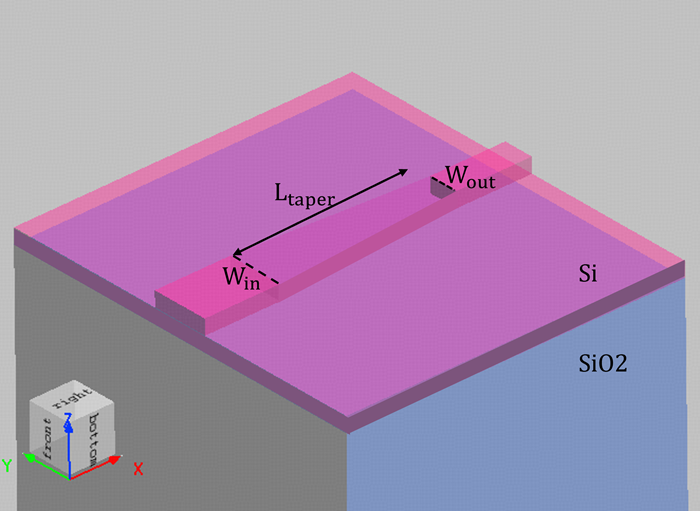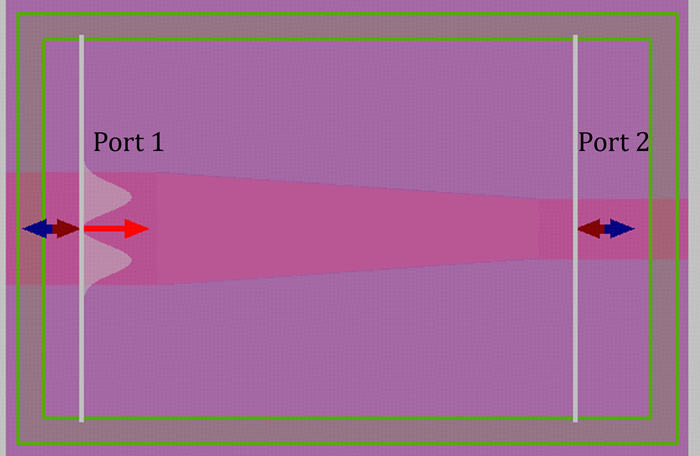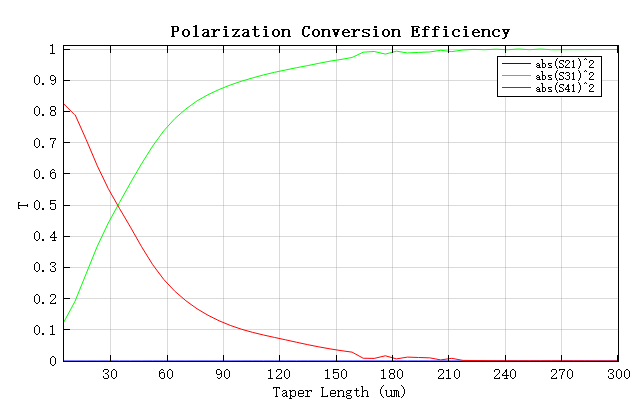Preface
Polarization converters are optical devices capable of efficiently transforming the polarization state of incident light from one form (e.g., TM mode) to another (e.g., TE mode). They play an important role in integrated photonics and polarization control applications. Common polarization converter designs include asymmetric waveguide sidewalls, stress-induced birefringence structures, and tapered waveguides with geometrical gradients. Among them, the tapered-waveguide-type polarization converter achieves efficient polarization conversion by enabling smooth energy coupling between different polarization modes through a gradually varying waveguide cross-section along the propagation direction. This structure offers advantages such as broad bandwidth, low loss, and high tolerance to fabrication errors, making it widely used in optical communications, polarization multiplexing, and polarization control in silicon photonic chips.

In this example, the FDE solver is first used to sweep the waveguide width and analyze the variation of the effective refractive index of the and modes, identifying the region where the two modes intersect to guide the design range of the tapered waveguide. Subsequently, the FDTD solver is employed to perform a three-dimensional simulation of the entire structure to calculate the light propagation and polarization conversion efficiency within the tapered waveguide.
Simulation settings
Device Construction
This example employs an SOI tapered rib waveguide structure, as shown in the figure above. The waveguide consists of a glass substrate overlaid with a -thick silicon layer, on top of which a -high rib is formed. The rib width gradually decreases along the propagation direction, and the values of and are determined from the FDE simulation. The refractive index of the materials are set to and , consistent with Ref. [1].
Source
In the FDTD simulation, a Port group is used as the source. The model contains two ports, located at the positions of and shown in the figure below, with serving as the input port.
Since this example focuses on the polarization conversion from the mode to the mode, the Mode Selection option in the port settings is set to User Select. The mode is selected as the input mode at , while is set to detect the , , and modes in order to analyze the output mode composition.

Simulation results
Mode Crossing Point
Open the taper_width_sweep.mpps project file and run the taper_width_sweep.msf script. The script automatically sweeps the rib width from down to , and records the variation of the effective refractive index () of the first five modes with respect to the waveguide width. To remove the contribution of the underlying slab to and ensure that the resulting effective index variation reflects only the effect of the rib structure on the mode properties, the obtained values are subtracted by the reference value of the slab waveguide (without ribs), = 2.754047.

The sweep results, as shown in the figure above, indicate that the neff curves of the and modes intersect at a waveguide width of approximately . This region marks the key width range where mode coupling and polarization conversion occur.
Mode Conversion Efficiency
Based on the FDE simulation results, the waveguide width at the input and output ends in the subsequent FDTD simulation are set to and , respectively. This width range is consistent with the design in reference [1:1], ensuring that the tapered waveguide effectively covers the mode crossing region between and .
At (waveguide width ), the mode is selected as the input source, while at (waveguide width ), the , , and modes are selected as the output monitors.
The attached pol_converter.mpps project includes a parameter sweep that varies the taper length ().
After the sweep, the -parameters obtained at represent the mode conversion efficiencies: for the transition from to , for the transition from to , and for the transition from to .
Since the simulation is computationally intensive, the sweep range in the attached project is set to . To provide a more complete view of the mode conversion trend, the results shown in this example extend the sweep range to , as illustrated in the figure below.

The results show that the mode transfers almost no power to the mode. As the taper length increases, the mode gradually converts into the mode. When the taper is sufficiently long, the mode can be efficiently converted into the mode with negligible loss, achieving high polarization conversion efficiency.




